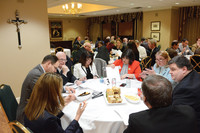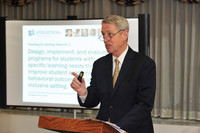

When the second phase of the Pathways to Excellence strategic planning initiative for the Catholic elementary schools of the archdiocese was launched back in September, I was there. It made sense that I also was present at last week’s reception for final input to the plan’s objectives and strategies.
The main participants were about four dozen educators, including some from the Superintendent of Schools Office and others from the schools, regional education offices and parishes of the archdiocese. They had done the heavy lifting to get the plan this far.
The Feb. 8 reception, in Dillon Hall at the New York Catholic Center in Manhattan, was a chance to hear Dr. Timothy McNiff, the superintendent of schools for the archdiocese, offer his personal take on Pathways to Excellence II, as the initiative is known.
He didn’t shy away from the major areas the plan will address when it is formally released next month. He hit the high points of the committee work that addressed Mission and Catholic Identity, Teaching and Learning, Enrollment and Marketing, Student Services, Leadership, Communications and Marketing, and Governance.
The next morning, Dr. McNiff told me that all Pathways to Excellence II will seek to accomplish falls into two categories: continue to improve the quality of the schools in the archdiocese and make sure that they remain sustainable.
Under the quality heading, he spoke about the “two primary drivers” being the importance of finding “the best adults we can” to serve as administrators and teachers, and making sure the technology the schools are using is “current and relevant.”
Regarding sustainability, Dr. McNiff said the key is to make sure the seats are filled. Two keys to promoting enrollment, Dr. McNiff said, are putting together “robust after-school programs with lots of enrichment opportunities” and “expanding our footprint in helping kids with special needs,” which the archdiocese plans to do by hiring full-time special education teachers at two Catholic schools in the Bronx and two on Staten Island.
Pathways to Excellence II is a three-year plan, and Dr. McNiff said that the Catholic school system could expect regular strategic reviews from now on.
“We didn’t want to list so many objectives that we would never get to. That waters down the integrity of the effort,” he said. “If we can get to 36 months and have accomplished all of it, or are well on our way, that gives us credibility and momentum. Then, let’s get another plan done.”
During the reception’s working session, I listened to the fast-paced conversation between education officials, a regional superintendent and a principal at one of a half dozen tables helping to develop final recommendations for the strategies used to achieve each objective.
The next morning, I spoke with Linda Dougherty, the regional superintendent of the Northeast/East Bronx Catholic School Region, who interpreted some of what I heard at the reception.
She said that the Mission and Catholic Identity Committee, which she serves as the co-chair, has held meetings in person or by phone conference every two weeks since October.
Working cooperatively with educators, education officials, two priests and a deacon from across the archdiocese gave Ms. Dougherty an “awareness of how large the archdiocese is” as well as the different experiences and issues encountered by schools in different regions. She noted how important that perspective was because she is a relative newcomer to the archdiocese, arriving less than two years ago, after many years as a principal in the Diocese of Brooklyn.
When I asked her to speak about one of the Mission and Catholic Identity objectives, she selected the first one, which addresses “an effective Catholic school engaging local clergy and all religious in their faith formation program.”
The topic has taken on a greater importance with the advent of a school system that is primarily regional, Ms. Dougherty said.
Speaking of clergy, she said, “How are we inviting them to our schools? We want every one to know they are welcome in the school buildings to offer whatever they can.”